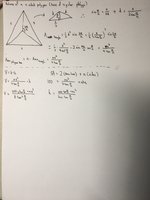Currently I am working on a project with optimization of prisms with a regular polygon base. It is similar to the investigation detailed here:https://ibmathsresources.com/2017/05/21/optimization-of-area-an-investigation/. In my project, a surface area of 100 is , and I'm trying to find the maximum volume a n-sided prisms will have. Anyways the problem is I end up with only two equation with three variables, and I am trying to find the optimal volume.
Sorry if this explanation is confusing, the attachment should explain it better.

Sorry if this explanation is confusing, the attachment should explain it better.

